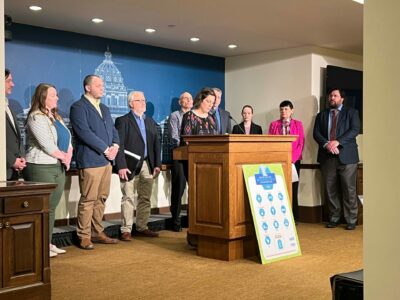On Tuesday, April 26, the Minnesota Section of ASCE unveiled its 2022 Report Card for Minnesota’s Infrastructure, the state’s first report card since 2018. The report assigned the state’s systems a cumulative grade of “C”, which is better than the national grade of “C-.” A “C” grade means the state’s infrastructure is in mediocre condition.
The report analyzes 10 categories of infrastructure pertinent to Minnesota: aviation (B), bridges (C), dams (C), drinking water (C-), energy (C), parks (B-), ports (C-), roads (D+), transit (C-) and wastewater (C). Minnesota Report Card co-chair Katie Zadrozny and Andy Nordseth presented the findings to an in-person audience at the Minnesota State Capitol building in Saint Paul, MN, while the Duluth Section of

Duluth press conference featured remarks from Emily Larson, Duluth Mayor, and Matt Baumgartner, President, Duluth Area Chamber of Commerce.
ASCE unveiled the report’s findings at a construction site in Duluth. The Saint Paul crowd received remarks from Rep. Dean Urdahl, R-Grove City; Sen. Sandy Pappas, DFL-St. Paul; Tom Worke, CEO, Associated General Contractors of MN; and John Linc Stine, Executive Director, Freshwater. The
Minnesota has taken steps to make its infrastructure network more sustainable to withstand increasingly severe weather, but additional steps must be taken as the state’s infrastructure is aging. Funding has been limited for systems throughout the state, particularly for surface transportation networks, and local and state funding must be increased to bring these critical systems up to speed.
Despite recent investments, Minnesota’s transportation network is severely underfunded. The federal Infrastructure Investment and Jobs Act (IIJA) will help, but local and state funding and financing is necessary to bring the state’s roads (D+), bridges (C), and transit (C-) network up to speed and meet matching requirements to qualify for federal funding. There are 874 bridges in poor condition in Minnesota, a decrease from 1,080 bridges in poor condition in 2017. While this is encouraging, the number of bridges that have slipped from good to fair condition is growing. More than 1,400 bridges are posted with load restrictions, which inhibits economic efficiency.
The state’s ports (C-) have sufficient capacity for current and future cargo demands – as the network currently supports movement of 65 to 75 million tons of cargo annually – but facility operators are encountering accelerated freshwater corrosion of steel structures, increased storm frequency and flooding, and dredging backlogs. Existing steel structures are being remediated utilizing unique corrosion remediation methods, but the costs of project requests for these needs are more than double currently available funding.
An emerging area of concern is the amount of lead in drinking water (C-), which is caused by lead service lines. In 2020, one community system in Minnesota exceeded the lead action level and 28 exceeded the copper action level; five noncommunity systems exceeded the lead action level, and six exceeded the copper action level. Much of the drinking water infrastructure in the state is over 50 years old, with some system components being closer to 100 years old and reaching the end of their useful life. Age has a direct correlation with system effectiveness and reliability.
As of 2020, Minneapolis averaged approximately 44 prominent water main breaks a year and most pipes involved were over 100 years old. In St. Paul, where the infrastructure is over 100 years old, the city averaged 124 water main breaks along its 1,200 miles of service lines from 2016-2021. The U.S. Environmental Protection Agency (EPA) estimates the 20-year drinking water infrastructure need for Minnesota is over $7.5 billion.
Public parks (B-) are among the greatest draws to the state with St. Paul being ranked No. 2 and Minneapolis No. 3 by the Trust for Public Land’s Park Score in 2021. Nature-based tourism contributes to the $12.5 billion annual sales that result from overall travel and tourism within the state. However, the state is challenged to maintain basic operations at many state recreation facilities and more and more people are engaging in the outdoors but funds available for basic maintenance and expansion have not kept pace.
The report also includes calls to action to raise the grades, including recommending the Minnesota legislature act to maximize available federal dollars through the IIJA by providing the required matching formula funds over the next five years, and encouraging water utilities, municipalities, and other infrastructure owners to consider adopting asset management strategies to stretch available dollars and prioritize needed repairs.
To view the report card and all 10 categories, visit https://infrastructurereportcard.org/state-item/Minnesota/.
